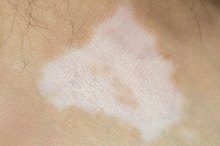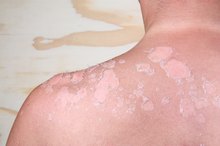What does fact checked mean?
At Healthfully, we strive to deliver objective content that is accurate and up-to-date. Our team periodically reviews articles in order to ensure content quality. The sources cited below consist of evidence from peer-reviewed journals, prominent medical organizations, academic associations, and government data.
The information contained on this site is for informational purposes only, and should not be used as a substitute for the advice of a professional health care provider. Please check with the appropriate physician regarding health questions and concerns. Although we strive to deliver accurate and up-to-date information, no guarantee to that effect is made.
White Blotches on the Chest
The pigment melanin determines the color of your skin, hair and eyes. White blotches on the chest develop when the cells that produce melanin either die or cannot produce melanin properly. This skin condition is called vitiligo. According to MayoClinic.com, vitiligo usually begins in small areas of the skin and then slowly spreads 1.
Types
There are three main types of vitiligo: focal, generalized and segmental. Focal vitiligo occurs when white blotches only appear in a small area of the skin, such as the chest. Generalized vitiligo is characterized by white blotches that are widespread over the body. Segmental vitiligo occurs when color loss only effects one side of the body. According to the American Academy of Dermatology, generalized vitiligo is the most common type.
- There are three main types of vitiligo: focal, generalized and segmental.
- Generalized vitiligo is characterized by white blotches that are widespread over the body.
Symptoms
Skin Disorders That Cause Pigment Loss
Learn More
In addition to white blotches on the chest, those with vitiligo may experience premature graying of the hair. Gray hair may appear on the scalp, eyebrows, eyelashes and beard. The mucus membranes in the mouth may also lose their color. In some cases, the eyes may lose some of their color, according to MayoClinic.com 1.
- In addition to white blotches on the chest, those with vitiligo may experience premature graying of the hair.
- The mucus membranes in the mouth may also lose their color.
Causes
The exact cause of vitiligo is unknown, but several factors are believed to play a role in the development of the condition. Medline Plus notes that heredity may be partly responsible because there is an increased rate of vitiligo in families 2. Abnormal immune system responses seem to contribute to the development of the condition as well. Vitiligo is often associated with hyperthyroidism, pernicious anemia and Addison’s disease, according to Medline Plus 2.
Treatment
White & Dark Circles on Skin
Learn More
Initial treatment for vitiligo consists of light therapy, oral medications and topical medications, such as corticosteroids and immunosuppressants. If these efforts are unsuccessful, skin grafting may be used to transfer pigmented skin from other areas of the body to the white blotches on the chest. In severe cases, a procedure in which the colored areas of the skin are depigmented may be performed. This is only done as a last option, however, because the procedure is permanent.
- Initial treatment for vitiligo consists of light therapy, oral medications and topical medications, such as corticosteroids and immunosuppressants.
- If these efforts are unsuccessful, skin grafting may be used to transfer pigmented skin from other areas of the body to the white blotches on the chest.
Considerations
After treatment, some people regain coloring in the areas of lost pigment; however, new areas of discoloration often develop, according to Medline Plus 2. It is important to take extra sun protection care if you have vitiligo because the areas with no pigmentation are more susceptible to sunburn and skin cancer.
Related Articles
References
- MayoClinic.com: Vitiligo
- Medline Plus: Vitiligo
- Grimes PE. (2017). Vitiligo: Pathogenesis, clinical features, and diagnosis. Tsao H, ed. UpToDate.
- Baldini E, Odorisio T, Sorrenti S, et al. Vitiligo and Autoimmune Thyroid Disorders. Front Endocrinol (Lausanne). 2017;8:290. doi:10.3389/fendo.2017.00290
- Dermatologist offers unique treatment for vitiligo skin discoloration. UT Southwestern Medical Center. July 16, 2015.
- Genetics & Incidence. Vitiligo Support International.
- Vitiligo: Diagnosis and treatment. American Academy of Dermatology.
- Liu LY, Strassner JP, Refat MA, Harris JE, King BA. Repigmentation in vitiligo using the Janus kinase inhibitor tofacitinib may require concomitant light exposure. J Am Acad Dermatol. 2017 Oct;77(4):675-82. doi: 10.1016/j.jaad.2017.05.043
- Vrijman C et al. The prevalence of thyroid disease in patients with vitiligo: a systematic review. Br J Dermatol 2012 Dec;167(6):1224-35. doi: 10.1111/j.1365-2133.2012.11198.x
Writer Bio
Lindsay Boyers has a Bachelor of Science in nutrition from Framingham State College and a certificate in holistic nutrition from the American College of Healthcare Sciences. She is also a licensed aesthetician with advanced training in skincare and makeup. She plans to continue on with her education, complete a master's degree program in nutrition and, ultimately, become a registered dietitian.








